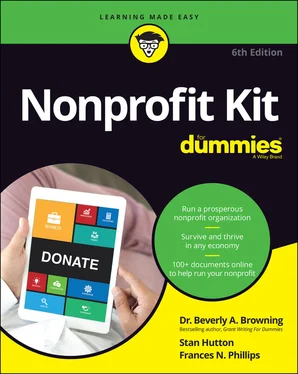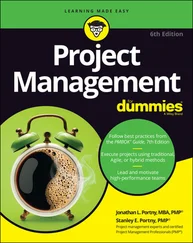What do your board members need to remember when they’re out and about in the community? “We educate, empower, and enlighten your staff through affording training programs.” This is short, sweet, and memorable — and it makes sense when the full mission statement is shortened.
 Think of your mission statement as a one-minute elevator speech. You have 60 seconds to describe your organization’s purpose and activities. Doing so is easy if you have a clear, short mission statement. Even if you have a longer mission statement, develop a 50- to 75-word spiel that you can recite from memory. Say just enough to capture the attention of listeners. After that, give them a business card with the nonprofit’s contact information (on the front) and the full mission statement (on the back).
Think of your mission statement as a one-minute elevator speech. You have 60 seconds to describe your organization’s purpose and activities. Doing so is easy if you have a clear, short mission statement. Even if you have a longer mission statement, develop a 50- to 75-word spiel that you can recite from memory. Say just enough to capture the attention of listeners. After that, give them a business card with the nonprofit’s contact information (on the front) and the full mission statement (on the back).
Stating your mission — the goal for services
When thinking of your organization’s reason for existing, think of your desired end result. What would you like to see happen? What would the world (or your community) be like if your organization were to succeed?
To say that you have to have a mission to change lives seems almost too basic. Maybe you’re thinking, “ Of course I have a reason for forming my nonprofit. Why do you think I bought this book? I want to start a nonprofit to [fill in the blank].” We bring up this point because clarifying the reason for your nonprofit’s existence is basic to creating your mission statement. Why should your nonprofit exist?
For example, you may know that you love cats and dogs and have always wanted to work with them, but that isn’t the same thing as identifying a nonprofit organization’s reason for existing. The mission statement for a fictitious humane society might be written this way:
Friends of Animals provides temporary shelter and medical care for homeless puppies, dogs, kittens, and cats until responsible, loving homes can be found.
This sentence doesn’t describe the shelter’s facilities or how it recruits and trains volunteers, but it does clearly state which animals it serves and that it doesn’t intend to foster them as long as they live but rather to place them in good homes. And if someone visited Friends of Animals with a ferret, a pony, or a tarantula, its staff would know to refer that person to another shelter.
 Knowing and understanding your organization’s purpose is essential to making important organizational decisions. It’s also a fundamental tool to use when asking for money, recruiting additional board members, hiring and motivating staff, and publicizing your activities. Also, remember that your governing board’s input in developing the mission statement is not an option. Buy-in begins with inclusion!
Knowing and understanding your organization’s purpose is essential to making important organizational decisions. It’s also a fundamental tool to use when asking for money, recruiting additional board members, hiring and motivating staff, and publicizing your activities. Also, remember that your governing board’s input in developing the mission statement is not an option. Buy-in begins with inclusion!
Specifying who will be served by the nonprofit
After you and the governing board have determined the nonprofit’s purpose, the primary beneficiaries of its services are documented and included in the mission statement. Their needs — whether they’re kittens or refugees — make your mission compelling and achievable. Defining who will benefit from your nonprofit helps to focus your organizational activities and is an essential ingredient in the mission statement.
Some organizations have a more general audience than others. If your nonprofit’s focus is preserving historic buildings, the beneficiary of this activity may be current and future residents of a city, a county, or even a state. It may also be the workers you train in the crafts needed to complete the building restorations.
Explaining how you’ll accomplish your mission
After you know your organization’s mission and its beneficiaries, the next step is deciding how to make it happen. Mission statements usually highlight a phrase describing the methods your nonprofit will use to accomplish its purpose. Think about the activities and programs you’ll provide to fulfill your mission. Take a look at these examples:
To indicate how it will accomplish its mission, the Friends of Animals’ mission statement may say, “Our mission will be accomplished by veterinary professionals and dedicated volunteers who provide temporary shelter for homeless animals.”
The mission of a human-services nonprofit organization may state, “Our mission will be accomplished by providing juvenile offender reentry recidivism counseling-and-support services for minority probationers exiting the Nassau County Juvenile Detention Center.”
 When describing how your organization addresses its purpose, you don’t want to be so specific that you have to rewrite its mission statement every time you add a new program. At the same time, you want the mission statement to be concrete enough that people reading it (or hearing you recite it) can picture what your organization does.
When describing how your organization addresses its purpose, you don’t want to be so specific that you have to rewrite its mission statement every time you add a new program. At the same time, you want the mission statement to be concrete enough that people reading it (or hearing you recite it) can picture what your organization does.
Incorporating diversity, equity, and inclusion (DEI) into your mission statement
What does it mean to incorporate d iversity, e quity, and i nclusion (or DEI ) into your mission statement? Let’s look at who’s involved and how to add language that is direct and memorable.
Step 1:It takes a village! Involve the founder and/or executive director and the governing board in articulating a brief but striking DEI statement.
Step 2:Remember that adding DEI to your mission statement is core to the organization’s values and the way it will conduct business (programs and services).
Step 3:Use positive words like inclusive, celebrate, grow, freedom, experience, and commitment or committed.
Now let’s revisit this mission statement and start adding the DEI language:
Our mission is to provide juvenile offender reentry recidivism counseling-and-support services for minority probationers exiting the Nassau County Juvenile Detention Center by ensuring that our programs are inclusive to all and committed to celebrating diversity, equity, and inclusion for youth and their families during detention and post-detention.
As you can see, not all the parts of DEI have to be included. However, the parts you do include must have an impact on your service population.
DETECTING A WEAK MISSION STATEMENT
Here’s an example of a vague, unclear mission statement:
The Good Food Society works to maximize impact of the utilization of nutritious food groups to beneficially help people in need by proclaiming the good benefits of balanced nutrition.
You probably get the idea that this organization wants people to have better eating habits so that they can enjoy better health. But can it realistically help all people everywhere? Also, try reciting this statement to someone you’re trying to convince to contribute to your organization. Can you say tongue-tied?
Long, multisyllabic words don’t make a mission or vision statement more impressive. If anything, they have the opposite effect. In place of the preceding statement, try this type of wording for your mission statement:
Believing in the value of good nutrition, the Good Food Society aims to improve public health by providing information about the benefits of a balanced diet to parents of school-age children through public education programs.
Читать дальше

 Think of your mission statement as a one-minute elevator speech. You have 60 seconds to describe your organization’s purpose and activities. Doing so is easy if you have a clear, short mission statement. Even if you have a longer mission statement, develop a 50- to 75-word spiel that you can recite from memory. Say just enough to capture the attention of listeners. After that, give them a business card with the nonprofit’s contact information (on the front) and the full mission statement (on the back).
Think of your mission statement as a one-minute elevator speech. You have 60 seconds to describe your organization’s purpose and activities. Doing so is easy if you have a clear, short mission statement. Even if you have a longer mission statement, develop a 50- to 75-word spiel that you can recite from memory. Say just enough to capture the attention of listeners. After that, give them a business card with the nonprofit’s contact information (on the front) and the full mission statement (on the back). Knowing and understanding your organization’s purpose is essential to making important organizational decisions. It’s also a fundamental tool to use when asking for money, recruiting additional board members, hiring and motivating staff, and publicizing your activities. Also, remember that your governing board’s input in developing the mission statement is not an option. Buy-in begins with inclusion!
Knowing and understanding your organization’s purpose is essential to making important organizational decisions. It’s also a fundamental tool to use when asking for money, recruiting additional board members, hiring and motivating staff, and publicizing your activities. Also, remember that your governing board’s input in developing the mission statement is not an option. Buy-in begins with inclusion!










